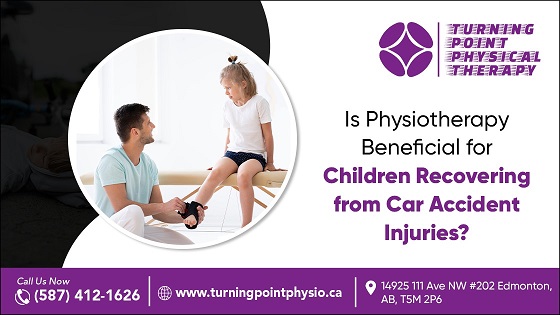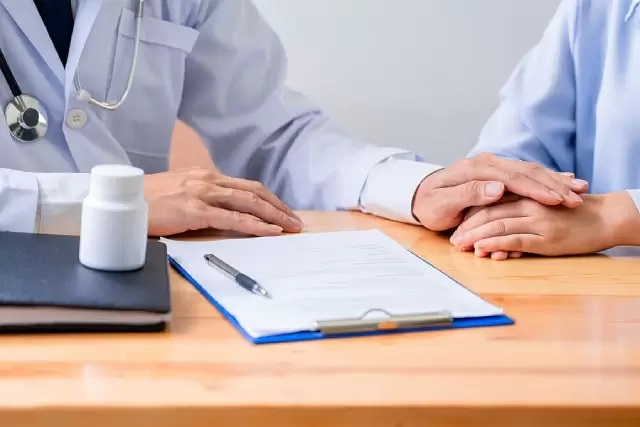Children recovering from motor vehicle accident (MVA) injuries face significant physical and emotional challenges. Occupational therapy in pediatric helps them regain daily skills, while pediatric physical therapy improves mobility, strength, and function. These therapies address physical injuries and emotional stress, promoting comprehensive recovery and enhancing quality of life. Motor vehicle accident physiotherapy Edmonton provides tailored techniques and exercises for young patients’ specific needs.
Understanding the Impact of Car Accident Injuries on Children
Car accidents can result in a range of injuries for children, including fractures, soft tissue injuries, whiplash, and traumatic brain injuries. MVA physiotherapy addresses these challenges by promoting healing, restoring function, and preventing long-term complications.
Types of Car Accident Injuries Children May Suffer
1. Head Injuries:
- Traumatic Brain Injuries: Resulting in headaches, dizziness, confusion, and behavioural changes.
- Skull Fractures: Involving breaks in the skull bones, often accompanied by bleeding or swelling.
2. Neck and Spinal Injuries:
- Whiplash: Straining or spraining of neck muscles and ligaments, leading to pain and stiffness.
- Spinal Cord Injuries: Spinal cord injuries vary in severity, potentially resulting in paralysis or loss of sensation and movement.
3. Bone Fractures:
- Arm and Leg Fractures: Ranging from simple to complex breaks, sometimes necessitating surgery.
- Clavicle (Collarbone) Fractures: It is commonly fractured, causing pain and restricting shoulder movement.
4. Soft Tissue Injuries:
- Bruises and Contusions: Damaged blood vessels under the skin, sometimes indicating more profound injuries.
- Sprains and Strains: Injuries to ligaments, muscles, or tendons from twists or impacts.
5. Psychological Injuries:
- Post-Traumatic Stress Disorder (PTSD): Anxiety, flashbacks, and emotional distress after the accident.
- Emotional and Behavioral Changes: It is like Irritability, mood swings, sleep disturbances, and concentration issues requiring mental health support.
Physiotherapy Techniques for Children Recovering from Car Accident Injuries
By utilizing car accident physiotherapy techniques to address their unique needs and ensure a smooth recovery. Here’s a detailed look at some critical exercises recommended for children by motor vehicle accident physiotherapy in Edmonton:
1. Manual Therapy
Joint Mobilization:
This technique helps children by improving joint function and reducing pain. Gently moving joints through their natural range of motion decreases stiffness and enhances mobility. It is especially beneficial for children with joint injuries or those who have been immobilized for extended periods, enabling them to perform everyday activities comfortably.
Soft Tissue Massage:
Soft tissue massage benefits children by reducing muscle tension, improving circulation, and promoting relaxation. It effectively addresses soft tissue injuries like bruises, sprains, or strains, enhancing blood flow for faster healing and pain reduction. Additionally, massage helps alleviate the emotional stress and anxiety associated with trauma, contributing to overall well-being.
2. Therapeutic Exercises
Strengthening Exercises
Strengthening exercises help children by enhancing muscle strength and supporting injured areas. These exercises focus on rebuilding the muscles around the injury site, providing better support and preventing future injuries.
- Bridge Exercise: Have the child lie on their back with their knees bent, then lift their hips off the ground to form a bridge, engaging their core muscles.
- Superman Exercise: Ask the child to lie down with arms extended overhead and legs straight. Simultaneously lift the arms, chest, and legs off the ground, keeping the head and neck aligned. Hold briefly to strengthen lower back muscles, alleviate pain, and improve spinal health.
Flexibility Exercises
Flexibility exercises improve the range of motion to prevent stiffness, which is crucial for children recovering from car accident injuries. These exercises lengthen muscles and improve joint mobility.
- Dynamic Stretching: Incorporate exercises such as arm circles and leg swings to improve range of motion.
- Static Stretching: Include static stretches like hamstring stretches and calf stretches to lengthen muscles and improve muscle elasticity.
Balance and Coordination Exercises
These exercises are essential for restoring stability and preventing future injuries. They help retrain the brain and body to work together efficiently, necessary for children who may have experienced balance and coordination issues due to their injuries.
- Single-Leg Stands: Have the child stand on one leg while holding a surface for support, gradually increasing the duration as their balance improves.
- Obstacle Courses: Create a simple obstacle course with cones or pillows for the child to navigate, promoting coordination and balance.
3. Neurodevelopmental Techniques
Gross Motor Skills Training
Gross motor skills training enhances large muscle movements such as walking, running, and jumping. This training helps children regain essential motor functions crucial for daily activities. Activities like obstacle courses and playground play improve strength, coordination, and confidence in performing large movements.
Fine Motor Skills Training
Fine motor skills training improves small muscle movements like gripping and manipulating objects. This training is vital for children to perform everyday tasks independently, such as dressing, eating, and school-related activities. Tasks like threading beads or playing with clay refine hand-eye coordination and agility, which are essential for functional independence.
4. Pain Management Techniques
Electrotherapy
Electrotherapy benefits children by reducing pain and inflammation through electrical currents. It is effective for managing chronic pain. Devices like TENS provide gentle electrical stimulation to the affected areas, reducing pain, promoting relaxation, and enhancing healing.
Heat and Cold Therapy
Heat and cold therapy manage pain and swelling in children. Heat therapy relaxes muscles, improves circulation, and reduces inflammation to relieve pain. Cold therapy constricts blood vessels by reducing swelling and inflammation to aid faster healing and prevent further tissue damage.
Collaborative Efforts for Successful Rehabilitation From MVA
Motor vehicle accident physiotherapy in Edmonton benefits children recovering from car injuries, and collaboration between parents and physiotherapists is crucial for optimal outcomes. At Turning Point Physiotherapy in Edmonton, the dedicated team of pediatric physiotherapists guides you and your child through every recovery step. Contact them today to schedule a consultation and learn how their specialized programs can help your child recover effectively.
Together, we can work towards your child’s healthier, happier future.
Read more: Weight Vests and The Advantages of Using While Working Out



